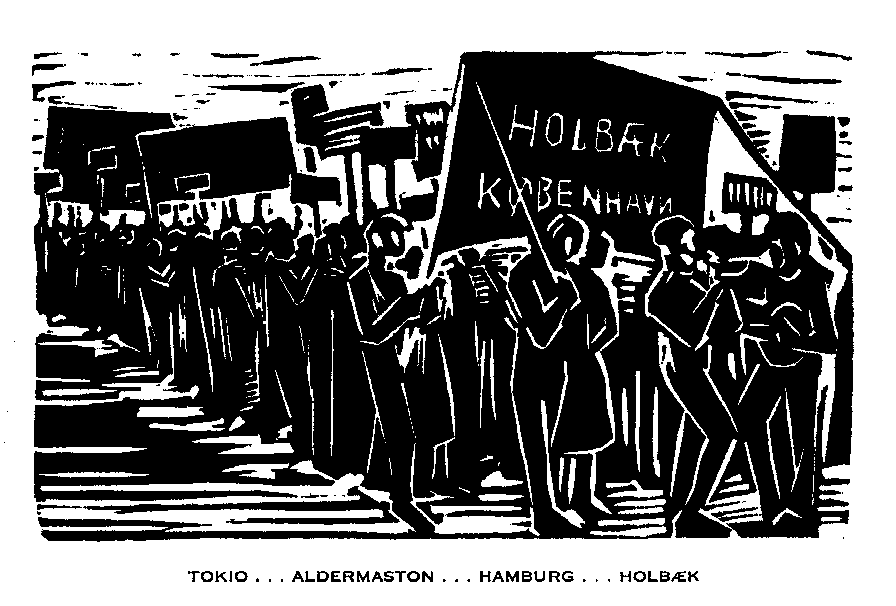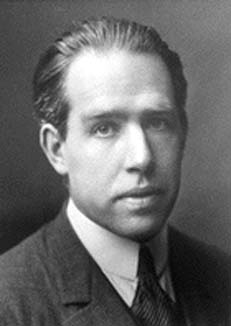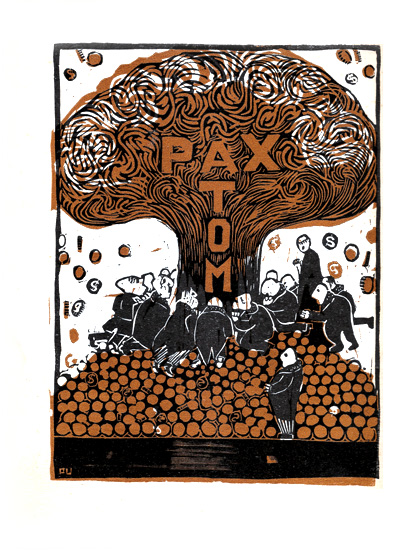The Danish Peace Academy
Holger Terp: Danish Peace History
Working paper 1
The Campaign for Nuclear Disarmament


From the end of World War two the main focus of nuclear weapons had been on power and deterrence. Back in 1944 the Danish nuclear scientist Niels Bohr (1885-1962) recommended to the UK Prime Minister Winston Churchill the establishment of international control over the use of nuclear weapons.
Shortly before the beginning of the Korean war June 9, 1950 Bohr wrote an open letter to the United Nations, because “The promise and danger involved in the technical advances have now most forcibly stressed the need for decisive steps towards openness as a primary condition for the progress and protection of civilisation”164.
The Danish debate over nuclear weapons came after the North Atlantic Council in December 1956 approved a political directive to NATO’s military authorities. According to the historians Jonathan Søborg Agger and Lasse Wolsgård, the political directive stated, “that all NATO forces should have the capability to respond quickly and with nuclear weapons to any type of agression”. The United States stated that “modern weapons with nuclear capabillity would be offered to all NATO-countries. Thus, the Danish government was forced to formulate a policy on nuclear weapons. The Danish government declared in December 1957, that “the govenment would not stockpile atomic warheads and depoy IRBM's on Danish soil “under the present circumstances””. The Danish military wanted nuclear weapons and its air force trained the use of tactical nuclear weapons.165.
In the middle of the 1950s the general view on nuclear weapons policy changed with growing concern over health and environmental damages caused by atmospheric nuclear weapons tests166. The Einstein-Russell-appeal of 1955 saw the creation of many campaigns for nuclear disarmament. Inspired by England the Danish Campaign against Nuclear Weapons was created in January 1960 by members of the Danish chapter of the WRI. Late summer 1960 also saw the creation of the Union of Cathollic Workers Action.
 |
 |
By the parliamentarian election of 1964, the nuclear pacifists were so strong, that a new liberal Peace Political Peoples Party was created; however it failed after the election to be represented in the parliament167. In 1973 Klaus Jørgensen published the first academic thesis on The Nuclear Weapons Issue in Danish Politics, with Special Reference to the Campaign for Nuclear Disarmament168.
Anders Boserup (1940-1990) and Claus Iversen published a study on the Easter marches in the “past eight years”169. By then they had established the short lived Institute for Peace and Conflict Research Copenhagen.
Boserup was a member of the editorial board of the Journal of Peace Research 1972-1974 and worked also for SIPRI on international law relating to chemical and biological weapons170 - as an example from 1972: CBW and the law of war. From 1985 Anders Boserup played a key role in the European development of the theory on Non-Offensive Defence171. The work of Boserup and others sparkled a growing interest for peace and conflict research in Denmark172, culminating so far with the creation of the Working Group of the Academic Council of the University of Copenhagen on Peace and Conflict Research in 1983173, the Copenhagen Peace Research Institute in 1984 (now a part of the Danish Foreign Policy Institute) and the Transnational Foundation for Peace and Future Research in 1985 of Jan Øberg in Lund, Sweden.
The Easter demonstrations against nuclear weapons were followed by demonstrations against the Vietnam war. In January 1967 the Danish Bertrand Russell Committee was created to organise the second session of the International War Crimes Tribunal, which was forbidden to hold its session in Paris and Stockholm. Under much publicity and debate the second session was held at Roskilde, late November 1967. The report of the tribunal was published in 50 copies in English and in French each and 100 copies in Danish174.
The Danish police attacked a huge peaceful demonstration against the Vietnam War at the American embassy in Copenhagen on April 27, 1968175. Afterwards the Danish anti-Vietnam war groups split over discussions about imperialism176, but out of the Vietnam war movement grew the book shop Demos and its co-operation with the Danish chapter of the WRI on the analysing and mapping of the Danish arms industry and military research establishment177. A work still undertaken by the Danish chapter of WRI.
Also during the Vietnam war the Committe to help American Deserters aided former US soldiers in Denmark.
The revolt of the youth culminating with the partly occupation of the University of Copenhagen in 1968 began in the camps of the conscientious objectors in the 1950s.
At the same time the numbers of discarded drafted personnel grew rapidly. The conscientious objectors began organising in 1965 and by January 1967 they established their own union178. Up to 1973 the Danish numbers of conscientious objectors grew, and the politicians felt forced to change the conscription system to halt the growing political influence of the conscientious objectors.
In 1973, the yearly meeting of the Conscientious Objectors Union, was surveillanced by the military intelligence service179. The surveillance became the topic for investigations by two later commissions law courts and a third might be needed180. This story needs more research.
Notes

|

|
164 Bohr, Niels: To the United Nations. In:
Impact of Science on Society, Vol. I, No.2, 1950, pp. 68 Open
Letter dated 9 June 1950.
The Challenge of an Open World : Essays dedicated to Niels Bohr,
1989. p. 7.
Christmas Møller, Wilhelm: Niels Bohr og atomvåbnet,
1985.
Long,
Doug: Niels Bohr : The atomic bomb and beyond.
http://www-groups.dcs.st-and.ac.uk/~history/PictDisplay/Bohr_Niels.html
165 Den størst mulige fleksibilitet : Dansk atomvåbenpolitik 1956-60 / Jonathan Søborg Agger ; Lasse Wolsgård. Historisk Tidsskrift, 2001:1 pp. 76-109.
Trænet til atomkrig. / Thomas Berndt ; Peter Nyholm. In: Berlingske Tidende, 11/21/2004.
166 Nuclear Wastelands, 1995. In 1979 Professor Bent Sørensen, Department of Plastic Surgery and Burns Unit, Hvidovre Hospital, University of Copenhagen published a study: Burns : Management of burns occurring as mass casualties after nuclear explosion. In Burns : The Journal of the International Society for Burn Injuries. Vol. 6 1979 no. 1, pp. 33-36.
167 Bertelsen, Aage: Her er dit våben, 1962. Bertelsen was a great inspiration for peace researcher Jan Øberg, TFF in Lund, Sweden.
Nordendorf Olson, Peter: Fredspolitisk Folkeparti : Et pacifistisk forsøg på opnåelse af folketingsrepræsentation. Odense University Press, 1985.
168 Jørgensen, Klaus: Atomvåbnenes rolle i dansk politik : Med særlig henblik på Kampagnen mod Atomvåben. Odense, 1973.
169 Demonstrations as a Source of Change : A Study of British and Danish Easter Marchers. Journal of Peace Research, Vol. 3, 1966 pp. [328]-348.
Jenkins, Robin: Who are these Marchers. Journal of Peace Research, Vol. 4, 1967 pp. [46]-60.
170 Nield, Robert: Anders Boserup : In Memoriam. In: NOD, 1990, No. 16 p. 4.
171 NOD & Conversion: Særnummer om 10 års dansk forskning i ikke-offensivt forsvar og om ”Global Non-Offensive Defence Network”, 1994, Vol. 30A, p. 3 and 5. See also: Hans-Henrik Holm : Science, Peace and Peace Research. - Århus : Institute of Political Science ; University of Aarhus, 1976. - 19 pp.
172 In 1982 several attempts to establish peace research institutions in Denmark were recorded by G. K. Wilson in his A global Peace Study Guide, including: the Danish Peace Research Group (Arbejdsgruppen for Freds- og Konfliktforsking) established in January 1977) and the Danish Peace Research Society. Some of the founding members of the Danish Peace Research Group were Maja Naur, Gunnar Adler-Karlsson, Hans-Henrik Holm, Jan Øberg and Jens Thoft. Jens Thoft were member of the International Working Group on Social Defence, established in July 1976.
Rasmussen, Søren Hein: Sære Alliancer : Politiske bevægelser i efterkrigstidens Danmark, 1997.
Rasmussen of the University of Århus describes careful and deeply social movements in Denmark after World War II: the peace movements, the movement against Danish membership of the EEC and the movement against nuclear power. Literature pp 289-299. Also references in notes pp 300-358.
173 Konsistoriums Arbejdsgruppe vedrørende freds- og konfliktforskning. The working group published: Fire forlæsninger om freds- og konfliktforskning på Københavns Universitet 1983. See also: “Proposal for Establishment of an International Council for Research and Information on Conflicts” by K. Helweg Petersen, Danish Minister for Disarmament Questions in cooperation with Dr. D. W. Bowett. 1971.
174 Tribunal, Nr. A1 C to N 2 C.
175 Madsen, Carl: Proces mod politiet. 1969.
176 Kampagnen mod Atomvåben og Vietnambevægelsen 1960-1972 / Søren Hein Rasmussen ; Johannes Nordentoft. Odense University Press, 1991
177 DDVs Dokumentationsgruppe: Rustningsindustri og krigsforskning i Danmark, 1973.
178 Militærnægterforeningen.
179 Forsvarets Efterretningstjeneste.
180 Kommissionsdomstole. Demos: Undergravende virksomhed : Beretning fra kommissionsdomstolen af 13. juli 1977. 1977.
|
|
|